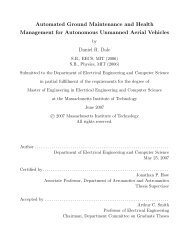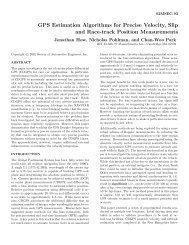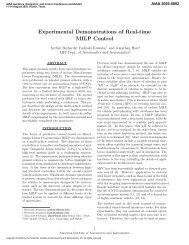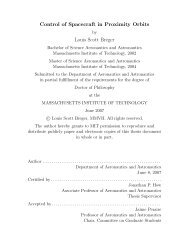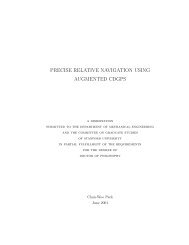Robust UAV Search for Environments with Imprecise Probability Maps
Robust UAV Search for Environments with Imprecise Probability Maps
Robust UAV Search for Environments with Imprecise Probability Maps
Create successful ePaper yourself
Turn your PDF publications into a flip-book with our unique Google optimized e-Paper software.
of the probabilities of target existence that capture any prior<br />
knowledge of the target existence. For example, if a mission<br />
designer was very certain that a target existed in a particular<br />
cell, a weighting of b = 50, c = 1 could be chosen,<br />
resulting in a distribution heavily skewed towards x =1.<br />
If the designer were highly uncertain of the target existence,<br />
a uni<strong>for</strong>m distribution could be used, by using b = c =1.<br />
Choosing higher values <strong>for</strong> b and c places more weight on the<br />
prior, and the updated distribution requires a larger number<br />
of observations (compared to a prior <strong>with</strong> lower values of the<br />
shaping parameters) <strong>for</strong> the measurements to have an effect<br />
on it.<br />
III. DEFINITIONS<br />
As in classical search theory, the update on the probability<br />
densities is done using Bayes’ Rule<br />
P (x|Y )=<br />
∫ 1<br />
0<br />
P (Y |x) P (x)<br />
P (Y |x)P (x)dx<br />
where: i) P (Y |x) denotes the likelihood function which is<br />
the probability distribution of the sensor that is being used;<br />
ii) P (x) denotes the prior distribution of the target; iii)<br />
the denominator serves as a normalizing factor to preserve<br />
the property of a distribution that its integral sum to 1; and,<br />
iv) P (x|Y ) is the posterior distribution, which is the updated<br />
distribution based on new measurements.<br />
In this paper, the prior is described by a Beta distribution<br />
as in Equation 1. The likelihood distribution is given by a<br />
series of N observations that indicate whether a target is<br />
detected or not in a cell. It is a Bernoulli distribution, since<br />
the sensor returns whether a target was detected or not. In<br />
the following equation, this is represented by Y =1if a<br />
target is detected, and Y =0if a target is not detected.<br />
(3)<br />
P (Y |x) =B n x γ1 (1 − x) γ2 (4)<br />
B n is the Binomial coefficient; γ 1 denotes the number of<br />
times a target is detected, and γ 2 indicates the number of<br />
times a target is not detected. Note that the total number of<br />
looks is given by γ 1 + γ 2 = N.<br />
Finally, define a sensor accuracy parameter, ξ, whichis<br />
the probability of “correct detections”; that is, the probability<br />
that if a target exists, then it will be detected by the sensor<br />
The probability of a missed detection is given by 1 − ξ. In<br />
general there are analogous probabilities in the case when<br />
a target does not exist, i.e., the probability of a correct<br />
rejection, χ, and a probability of false alarm, 1 − χ. For<br />
sake of generality, we will assume that ξ ≠ χ.<br />
IV. PROBLEM STATEMENT<br />
Having defined the notation that will be used throughout<br />
this paper, we now define the main problem statement.<br />
Consider a cell <strong>with</strong> an imprecise target existence probability,<br />
x, described by a Beta distribution. Taking a series of observations<br />
in a particular cell results in a new Beta distribution<br />
which is shifted rightward towards x = 1 if the noisy<br />
observations indicate a target exists, or leftward towards<br />
x =0if the opposite is true. The key point is that this new<br />
distribution will have an updated set of statistical moments<br />
which can be used to establish new confidence values <strong>for</strong><br />
the target existence. For example, if the expected value of<br />
the posterior distribution after a series of N observations<br />
is greater than a threshold α close to 1, we can declare<br />
that a target is in fact present in the cell. Likewise, if this<br />
expected value is less than an analogous threshold ˆα close<br />
to 0, the cell is assumed not to contain a target. Using our<br />
proposed framework, it is now possible to predict the number<br />
of looks that are required to exceed a pre-defined threshold to<br />
unambiguously conclude the presence or absence of a target<br />
<strong>for</strong> the case when the probabilities are precise.<br />
The first result in this section is <strong>for</strong> the case when only<br />
the expected value of the distribution is used as a criterion<br />
<strong>for</strong> the declaration of target existence or absence.<br />
Objective A: Expected Value Formulation Given predefined<br />
sensor errors and a prior described by the Beta<br />
distribution, find the minimum number of looks, N, that raise<br />
the expected value of the posterior distribution, ¯x(N), above<br />
a threshold α<br />
{ min N | ¯x(N) ≥ α } (5)<br />
Result A: The minimum number of looks, N = γ 1 + γ 2 ,<br />
required to raise the expected value of the posterior distribution<br />
to α, is given by<br />
(α − 1)b + αc<br />
N ≥ (6)<br />
ξ − α<br />
Thus, given knowledge of the sensor error, and prior<br />
weighting given to the prior distribution, we can estimate<br />
the number of looks required to achieve an expected value<br />
<strong>for</strong> the probability that a target is actually there.<br />
Proof: The proof consists of three steps: constructing the<br />
posterior distribution; finding the expected value of the<br />
distribution; and solving <strong>for</strong> N. The posterior distribution,<br />
P (x|Y ) is<br />
P (x|Y ) =<br />
∫ 1<br />
0<br />
P (Y |x) P (x)<br />
P (Y |x)P (x)dx<br />
= Γ(b + γ 1 + c + γ 2 )<br />
Γ(b + γ 1 )Γ(c + γ 2 ) xb+γ1−1 (1 − x) c+γ2−1<br />
The expected value of the posterior distribution is given by<br />
¯x =<br />
=<br />
∫ 1<br />
0<br />
xP(x|Y ) dx<br />
Γ(b + γ 1 + c + γ 2 )<br />
Γ(b + γ 1 + c + γ 2 +1)<br />
Using the property of Gamma functions that<br />
Eq. 7 simplifies to<br />
Γ(b + γ 1 +1)<br />
Γ(b + γ 1 )<br />
(7)<br />
Γ(m +1)=m Γ(m) (8)<br />
¯x =<br />
b + γ 1<br />
b + γ 1 + c + γ 2<br />
(9)<br />
5682



